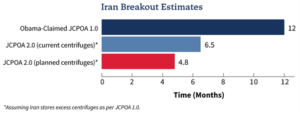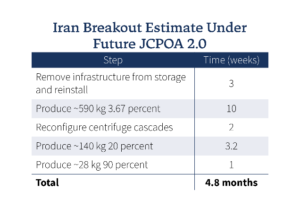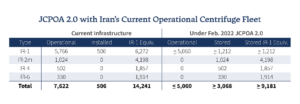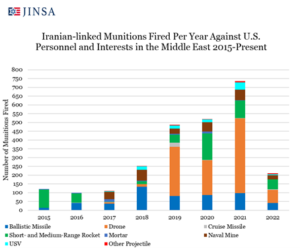Iran Summary – February 2022
About the Iran Summary: The Jewish Institute for National Security of America’s (JINSA) Gemunder Center produces a monthly tracker providing timely information and graphics illustrating Iran’s aggressive and destabilizing activities.
January 2022 Summary: No nuclear deal with Iran was reached in February, despite Western officials indicating that the end of the month was a final deadline for the talks. Instead, Iranian officials appeared to concede on a number of points before backtracking on nuclear enrichment and raising issues about the status of the Iranian Revolutionary Guard Corps (IRGC). As negotiations continued in Vienna, Iranian-backed groups a brazen escalation of their attacks by targeting the United Arab Emirates (UAE) with coordinated ballistic and cruise missiles as well as drones.
Response to Ukraine Crisis: Iranian President Ebrahim Raisi claimed in a call with Putin that “NATO expansion is a serious threat to the stability and security of independent countries in different regions.” Raisi also added that “what was happening” would help “the nations and the region.”

Nuclear: While Western officials have been warning for months that time is running out to reenter the JCPOA, officials expressed that the end of February would be a deadline to finish negotiations. The sides did not reach an agreement before the end of February, but appeared to be moving toward a deal, with the United States restoring a sanctions waiver on Iranian civil nuclear projects and Iranian officials tentatively agreeing to a prisoner exchange. Nevertheless, Iran stuck to its maximalist positions regarding the IRGC’s terrorist status and International Atomic Energy Agency (IAEA) investigations in Iran, and it also appeared to backtrack on earlier concessions regarding enrichment levels. Meanwhile, Iran also continued building its potentially impenetrable Natanz nuclear facility. If a restored JCPOA has the same terms that allowed Iran to store advanced centrifuges, JINSA estimates that the “breakout time would be 4.8-6.5 months until early 2026, at which point the JCPOA permits Iran to steadily shrink these timeframes further.”
- Chairman of the Senate Committee on Foreign Relations Bob Menendez gave a speech on February 1 arguing, “a year later, I have yet to hear any parameters of ‘longer’ or ‘stronger’ terms or whether that is even a feasible prospect. And even when it seemed a constructive agreement might be possible last summer, upon taking office, the Raisi government abandoned all previous understandings and, as I mentioned, made absolutely clear that Iran’s ballistic missiles and regional proxy networks are ‘not negotiable.’ Moreover, at this point, we seriously have to ask what exactly are we trying to salvage?”
- On February 3, it was reported that, late last year, U.S. officials had determined that Iran’s nuclear program was too advanced to restore the twelve-month breakout period that was a key goal of the original 2015 JCPOA.
- The Biden administration restored a sanctions waiver on February 4 that will allow countries to cooperate with Iran on civil nuclear projects.
- For months, the Biden administration has said that the window is closing to rejoin the JCPOA, and in early February administration officials claimed that the end of the month would be the unofficial deadline. After this point, Iran’s nuclear program would be too far advanced for a revived JCPOA to constrain it effectively.
- The White House’s lead Iran negotiator Rob Malley briefed behind closed doors the House and Senate foreign relations committees on February 8 and 9, respectively. The members of Congress had mixed reactions to the briefing with some arguing his presentation showed the urgency of reaching a deal and others arguing that open-ended diplomacy has not succeeded.
- Iranian Foreign Minister Amir Hossein Abdollahian said on February 19 that Iran was ready for an immediate prisoner exchange with the United States, which the United States had identified as a separate, prerequisite development for resolution of the nuclear talks.
- Israeli Prime Minister Bennett revealed in a speech on February 19 that Iran had been demanding that the United States delist the IRGC as a terrorist group and that the IAEA cease its investigation into the potential military dimension of Iran’s nuclear program.
- On February 25, the Head of Iran’s Atomic Energy Organization, Mohammad Eslami, said that Iran will continue to enrich uranium to 20 percent purity even if it reaches an agreement with the West to revive the 2015 JCPOA, contradicting the terms of an alleged draft deal discussed by Western media earlier in the month.
- A senior unnamed State Department official said on February 28 that “final decisions have to be taken this week – either we have a deal or we do not.”
 |
 |
|---|



Regional Aggression: Iran and its partner militias have continued their regional aggression campaign, including multiple attacks against civilian targets in Yemen, Saudi Arabia, and the UAE, three UAV invasions of Israeli airspace, and the transfer of precision-guided missiles and UAV production knowledge to Venezuela. According to JINSA’s Iran Projectile Tracker, Iranian-backed groups fired over fifty projectiles including roughly 30 ballistic missiles and 20 drones at U.S. interests during February.
- On February 2, UAE air defenses intercepted three drones launched by the little-known Iraqi militant group the True Promise Brigades.
- Houthi rebels launched four missiles from Hodeidah and the Sanaa International Airport toward Yemen’s northern Hajjah governate on February 8.
- Twelve people at the Saudi Abha International Airport were injured by shrapnel from a Houthi explosive-laden drone intercepted by Saudi air defenses over the airport on February 10.
- On February 11, it was reported that Turkish intelligence had worked with the Mossad to foil an Iranian assassination attempt against an Israeli businessman operating in Turkey.
- The IDF reported on February 17 that it had shot down a Hamas drone and a Hezbollah drone that were attempting to infiltrate the Lebanon and Gaza borders respectively.
- On February 20, Houthi rebels launched seven missiles at Marib, killing and wounding multiple civilians.
- A Houthi drone attack on Saudi Arabia’s southern Jazan Airport injured 16 people on February 21.
- On February 22, Israeli Defense Minister Benny Gantz revealed a photo that he said proved Iran was furnishing Venezuela with precision-guided missiles and technical knowledge to produce UAVs.
- Iraqi Shia militia Ashab al-Kahf carried out an IED attack on February 22 against a convoy supplying U.S. troops as it passed through Iraq’s Babil province.
- On February 24, Houthi rebels took hostage a former staffer from the long-closed U.S. embassy in Sanaa, now the eleventh former U.S. embassy staffer in Houthi custody.
- On February 28, Hezbollah claimed to have launched a UAV into Israeli airspace before returning to Lebanon intact.
 |
 |
|---|
Cyber: Iran continued its global cyberterrorism campaign, specifically targeting the Israeli Ashdod and Haifa ports. American cyber officials and private security firms further uncovered advances in Iran’s cyber capabilities and the extent of its global ransomware and cyber espionage campaign.
- On February 17, the American cyber security firm SentinelOne identified that TunnelVision, an Iran-backed hacking group, is newly exploiting the critical Log4j vulnerability to infect unpatched VMware users with ransomware.
- On February 23, Iranian hackers published CCTV footage and workers’ personal details from Israel’s Haifa and Ashdod ports. Israeli port authorities claimed the images were outdated and stolen from company records rather than site cameras.
- the American NSA and FBI along with the U.K. cyber authorities released a report on February 24 detailing how the Iranian hacker group known as MuddyWater has been conducting cyber espionage and other malicious operations targeting telecommunications, defense, local government, and oil and natural gas sectors in Asia, Africa, Europe, and North America.
Domestic/Human Rights: As teachers continue to protest across Iran for better wages and the release of imprisoned activists, Iran continues to stand out globally for its harsh treatment of prisoners and record high rate of executions, notably against minors and LGBT individuals. Iran is also pushing internet censorship and surveillance legislation to further clamp down on freedom of speech.
- Iran executed two gay men on February 5 accused of “forcible sodomy.” Iran, which has one of the world’s top execution rates, is on track to keep up its record, with a 26 percent increase in 2021.
- On February 17, a Kurdish prisoner at Iran’s western Ilam prison went on a hunger strike after being severely tortured and transferred to solitary confinement.
- On February 18, thousands of teachers across Iranian cities continued to protest for higher salaries and for the release of colleagues arrested in previous rallies. At the protest in the city of Karaj, security forces attack protesters and arrested 15 of them.
- A bill in the Iranian Majlis that would severely increase Iranian government internet censorship and surveillance passed a parliamentary committee on February 22, a significant step toward curtailing internet freedom in Iran.
- Iranian authorities arrested a prominent Iranian blogger, Ronaghi Maleki, on February 23 after he posted Tweets critical of the passage of the Majlis’ controversial bill to curtail internet freedom.
Recent JINSA Publications on Iran:
-
- February 1: Time Never Seems to Run Out for Iran Negotiations, Jonathan Ruhe, Andrew Ghalili, and Sam Millner, JINSA NatSec Brief
- February 4: “Here’s how the US can reestablish a measure of deterrence against Iran,” John Hannah and Ari Cicurel, Defense News
- February 8: “Iran nuclear deal will be a tough sell in Congress,” Stephen Rademaker, Al-Monitor
- February 10, 2022: Iran’s Unprecedented Wave of Attacks Against the UAE, JINSA NatSec Brief
- February 11: The Urgency of Now: The Administration and Congress on Time Running Out For Iran Deal, Jonathan Ruhe and Andrew Ghalili
- February 21: “No more extending the clock on the Iran nuclear deal,” Blaise Misztal and Jonathan Ruhe, The Hill
- February 23: Iran’s Short Breakout Time Under JCPOA 2.0, Blaise Misztal and Jonathan Ruhe